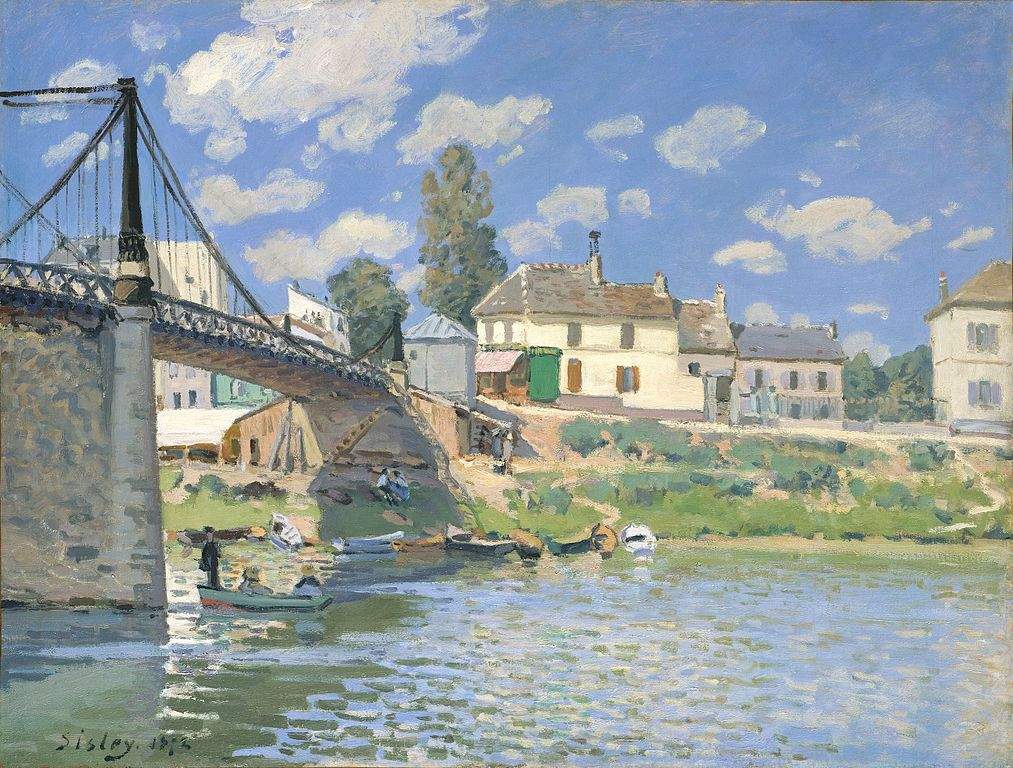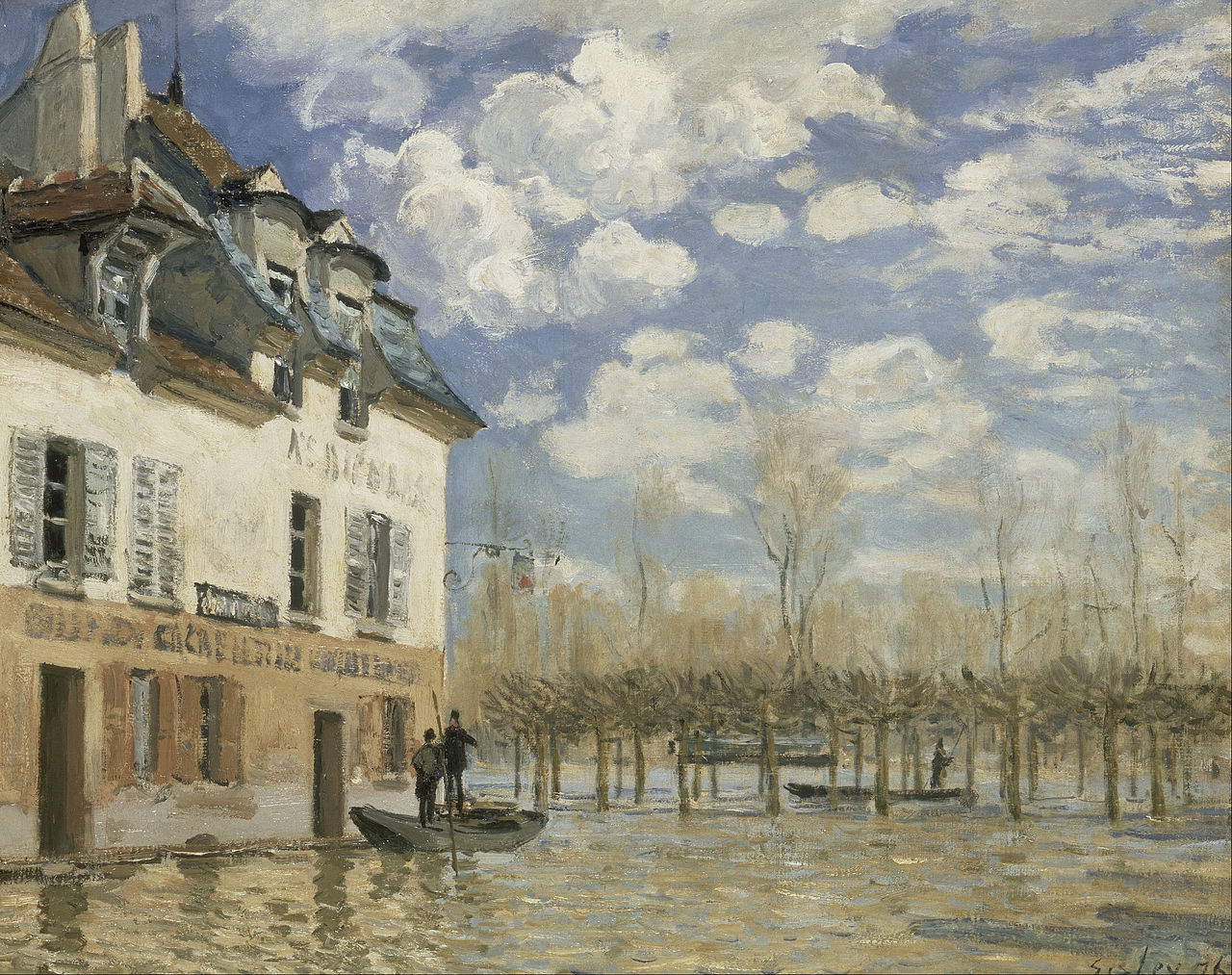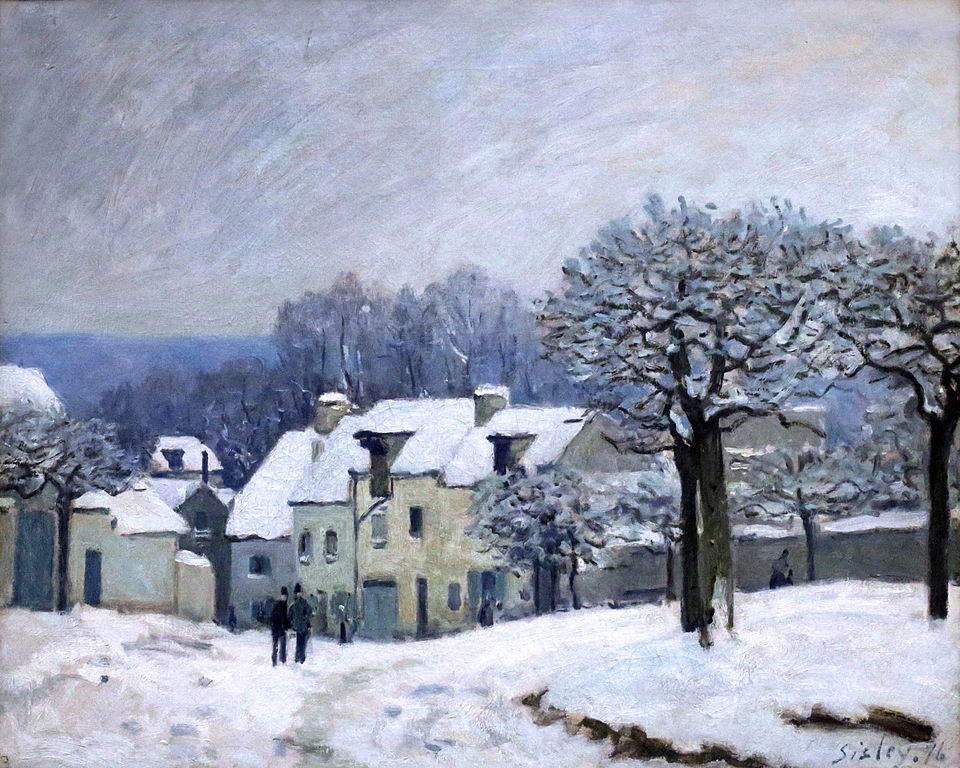Alfred Sisley (Paris, 1839 - Moret-sur-Loing, 1899) was one of the major Impressionist painters: many consider him to be French, because he lived all his life in Paris, but he was actually a British national.
Auguste Renoir ’s son recounts that his father described Frédéric Bazille and Sisley as the artists, who entered the studio of the well-known Swiss painter Charles Gleyre, master of several Impressionists, and wanted to “set fire to the firemen”: they were in fact two young men who drew with patience and diligence, determined to achieve perfection in a short time.
Peers described Sisley as polite and quiet: Vincent Van Gogh in one of his letters to Brother Theo described him as “the shyest and kindest of the Impressionists,” and Renoir’s son also said that “Sisley’s gift was gentleness.” Sisley depicted landscapes throughout his life, painting in the open air, always remaining faithful to the Impressionist cause.

Alfred Sisley was born in Paris on October 30, 1839, to an English family: his father William Sisley was from Manchester, a businessman and merchant, and his mother Felicia Sell came from an old family of London intellectuals. She saw to her son’s education by bringing him closer to the arts and music. Reaching the age of eighteen, Sisley was sent by his parents to England to study commerce, but it did not quite work out that way; he took advantage of the trip to go and learn about and study English culture. He stayed in England from 1857 to 1861, studying both English literature (even going to visit William Shakespeare’s town of Stratford-upon-Avon) and painting. It was with the discovery of William Turner and John Constable that Sisley fell in love with the landscape genre, but especially with the freedom of these artists’ mark-making. He returned to Paris in the spring of 1862 and managed to get permission from his parents to study painting; in October of that year he entered the studio of Charles Gleyre (Chevilly, 1806 - Paris, 1874), where Claude Monet, Pierre-Auguste Renoir and Frédéric Bazille had also come to study. A strong friendship developed between them that lasted over the years. The four soon left Gleyre’s studio: they had different visions and ideas about landscapes and their realization.
In 1863, Sisley and his friends left Paris to go to the vicinity of Fontainebleau, to paint outdoors he wanted to best capture natural light and its colors(en plein air). The experience was very formative and was repeated by the four again in 1865, in search of a new way of painting nature, and they created a style of their own, what would later go down in history as Impressionism. Sisley began an affair with Marie-Eugénie Lescouezec in 1866: the two lovers were portrayed a few years later by Renoir(The Sisleys, 1868), did not marry until 1897, and had three children. Protected by the family’s financial stability, Sisley was able to devote himself fully to his painting. Sisley and Marie moved to Paris, a city that at that time oozed with salons of intellectuals where they could discuss art and ideas. Sisley often attended informal gatherings held at Café Guebois by Édouard Manet (who inspired a new generation of painters), where new artistic solutions, techniques, and themes were discussed.
Sisley’s father made a series of bad deals because of the Franco-Prussian War (1870-1871), and the whole family suffered the consequences of these mistakes. From that moment Sisley’s life changed: no longer supported by his father’s finances, he would have to support himself, trying to make as much as possible from his work. In 1872, Camille Pissarro and Monet introduced him to Paul Durand-Ruel owner of an art gallery in London (he was a great supporter of the Impressionists), who exhibited him until the end of his days; supported also by the critic Théodore Duret, Sisley managed to keep afloat financially, thus being able to support his family and pay for his painting materials.
Sisley, in 1874, participated in the first Impressionist exhibition, an exhibition held at the photographic studio of Félix Nadar . It was organized independently by the group of painters who exhibited there. Among those present were: Claude Monet, Renoir, Pissarro, Edgar Degas and the painter Berthe Morisot. Sisley participated with few landscapes, not arousing the interest of critics. After the first exhibition Sisley returned to England for a few months to better study English paintings; at that time his palette became much more colorful. With his return to France, he moved to Marly le-Roi where, devoting himself to en plein air painting, he would make his best paintings studying the reverberation of water and its colors(Flood at port-Marly, 1876).
During the third Impressionist exhibition (1877), Sisley showed his last works with water, from which he obtained good success but this was not enough: economic difficulties were growing and the paintings were not selling well. In 1879 he decided to try a more classical approach by attempting to exhibit at the Salon, an annual painting exhibition devoted mainly to academy students, which gave a chance to show himself to the general public: works that were exhibited at the Salon certainly sold but more importantly one was accepted by the Parisian intellectual elite, a good opportunity for Sisley’s economic difficulties. However, he was rejected by the jury and did not exhibit. Because of continued failures and economic difficulties, Sisley and family moved first to a small town on the banks of the Loing and then to the small town of Moret.
As the group of Impressionists was crumbling, group exhibitions were becoming increasingly rare, and Sisley, following the examples of Monet, Renoir and Pissarro, decided to have solo exhibitions through the Durand-Ruel gallery. He participated in his last Impressionist exhibition in 1882 (seventh exhibition, the eighth he did not attend was the group’s last in 1886) continuing to be unsuccessful. In 1886 he decided to accept Durand-Ruel’s proposal for a group exhibition in New York finally meeting with success, thus giving him the opportunity to make himself known to the art dealer Georges Petit: he became his official gallerist with whom he would collaborate for the rest of his years. Petit organized a major exhibition of Sisley’s work, exhibited 46 paintings and 6 pastels, but not a single work was sold, and it was a blow to the artist. During this period Sisley tried several times to apply for French citizenship, but for bureaucratic reasons or lack of documents he was never granted it. In 1898 Sisley lost his wife, and the loss was so painful that the artist stopped painting. His condition worsened, for after the pain on the psychological side came the physical one: a malignant tumor in his throat. Upon discovering his condition he had Monet called to whom he recommended his children, and he died at Moret-sur-Loing on January 29, 1899.




Throughout his life, Sisley painted landscapes, depicting them with Impressionist power, but unlike his colleagues who wanted to show the power of nature, he portrayed it quietly, and his paintings are almost dreamlike moments of relaxation that nevertheless transport the viewer to a specific time and place. His early paintings were characterized by a dark palette and a very severe attitude: one can see an attachment to perspective that is linear and reasoned, as in Women Going to the Woods of 1866.
His style changed after his trip to England: he returned to Paris in 1870 and began painting with a much brighter palette and began painting a theme that would haunt him throughout his life: water and its reflections. One can see the differences between an 1872 painting, The Bridge of Villeneuve-la-Garenne, and one from 1876, Flood at Port-Marly: both depict water and its reflections, but while in the first example there is still an idealized vision, the geometries are precise and the water and the sky still unconvincing, in the second painting, on the other hand, there are major differences, one can see that Sisley has studied in depth thewater and its reflections but also the sky, as here he fully captures the real datum (the light and its reflections) while sacrificing the geometric part, the house loses its precise contour and blends with the colors that surround it (note that still the perspective remains exact).
Sisley’s perspective vision changed when he encountered Japanese prints, and so, influenced by his friend Monet and Pissarro, he began to experiment. With them he studied the reflections of snow and its colors, for example in Effect of Snow at Argenteuil (1874). Art historian Richard Shone compares a painting by Sisley(The Kennel Square at Marly, Snow Effect, 1876) and a print by Utagawa Hiroshige(Snowy Night at Kambara, c. 1833/35) to emphasize the change in perspective vision and the great influence of Japanese prints on Sisley.
Sisley favored painting en plein air: he used to buy canvases for sale in art stores, so that he would have canvases that were standard in size but more importantly convenient to transport. This type of ever-changing surface suggests the creation of works in series. Sisley made many series such as that of the houses in Saint-Mammès (one example, Old Houses in Saint-Mammès, 1880) or even the various alleys and banks of the Loing(Alley of Poplars around Moret-sur-Loing, 1890). Another small series is the one devoted to the church of Moet: Sisley paints it at various times of the day and from various angles, in several works all from 1894 (such as The Church of Moret - rainy weather, The Church of Moret - overcast sky, The Church of Moret - in the rain, The Church of Moret - evening).
In his later years he devoted himself more and more to depicting grand nature by going on to paint the sea, particularly the cliffs of Langland its rocks and waves, always paying close attention to light and color(Storr’s Rock, Langland Bay - evening, 1897).



Most of Sisley’s works are in France: in Paris, at the Musée d’Orsay, most of his works are housed, such as View of the Canal de Saint-Martin (1870), The Flood at Port-Marly (1876) and Alley of Poplars around Moret-sur-Loing (1890). Also in Paris, his works are in the Louvre Museum and the Petit Palais Museum. In France his works can be seen in several other museums, such as at the Palais des Beaux-Arts in Lille and in Le Havre at the André-Malraux Museum of Modern Art.
Also in Europe we find his works in Germany, at the Staatsgalerie in Stuttgart and the Kunsthalle in Hamburg. In the United Kingdom, we admire works by Sisley in England, at the National Gallery in London, and in Scotland, in Glasgow in the Burrell Collection. In Italy we have only one work in Milan at the Galleria d’arte Moderna: it is Wind and Sun of 1880.
Overseas many of his works are in the United States particularly in New York at the Metropolitan Museum of Art and the Philadelphia Museum of Art, and in Canada at the Museum of Fine Arts in Montreal.
 |
| Alfred Sisley, life, works and style of one of the greatest Impressionists |
Warning: the translation into English of the original Italian article was created using automatic tools. We undertake to review all articles, but we do not guarantee the total absence of inaccuracies in the translation due to the program. You can find the original by clicking on the ITA button. If you find any mistake,please contact us.